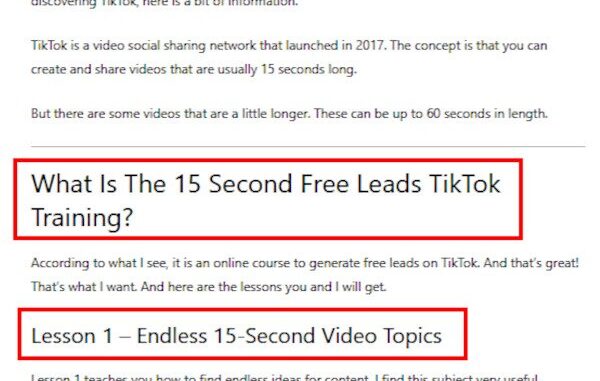
Timotheus Update: This post was originally published on 16 July 2021 on my previous website – Passive Online Revenue. Due to rebranding and consolidation of the two sites, the post is now on this website and published on 5 April 2023.
On Page SEO – Headings – 3rd of 12 Techniques That Work | Episode 6 | Digital Marketing 101
This is the 6th episode of Digital Marketing 101 series. And it is about the 12 On Page SEO techniques.
What are Headings? How to write a powerful and effective Headings?
At the same time, it makes it easier for the search bots to understand what your website or web page is all about, too. Google and other search engines look at headings to determine how relevant the page is to a user’s search query.
This is because when you have headings within your content, it will be seen as texts of higher quality. It is seen as such because the headings makes it easier to read your content.
When visitors cannot find what they are looking for, they will quickly leave your website. As such, by having easily scannable content, you help your visitors to stay longer on your web page. Better still, after scanning, it helps them to realize it is what they are looking for, and they continue to read your article.
This will lower bounce rates. And that is one of the ranking factors that impact SEO.
So, now I’m going to share with you how to write powerful and effective headers.
As mentioned above, a scannable article is a readable article. And a readable article is one that is more likely to perform well in the search engines.
Make sure the headings are related to the primary keyword/header for that page. Also, use headings that are relevant to content, that is to each section.
Each header should give the reader an idea of the information they are going to get from the section below, and also from the paragraphs of text. This will make the text more scannable and more readable.
Again, the more scannable your content, the more readable it is. And visitors stay on your web page longer. And, as a result, you will get lower bounce rate, which is very good for SEO.
H1 is for the main heading of your web page or post. It can also be the title of your article.
Please take note that H1 should be between 20 and 70 characters.
You should add the keyword that you are ranking for into this main header. Preferably, you should use a Focused Long-Tail Keyword in Your H1.
Important Tip – Add Keyword to H1 only. For H2 to H6, write naturally. Make sure headers are relevant to section content.
When a person makes a search query, and the query is answered, Google and other search engines actually look at these headers. And they actually use the headers to outline different list items on search results.
As you can see from the image below, Google used the headers to create its own bulleted and numbered lists as featured snippets in response to the search query.
Here are some additional tips. Do Not use special characters like $, %, @, etc.
On Page SEO – Headings – 3rd of 12 Techniques That Work | Episode 6 | Digital Marketing 101
In my next blog post, I will share about another On Page SEO technique. It will be about the Image Alt Text Tag. Remember to join my I Love Passive Income community to get updated whenever I publish a new blog post.
Join the Wealthy Affiliate as a Starter member for Free! And get access to free training on starting and growing an online business as well as many free features and tools (including powerful keyword tool). Plus, you get to create a website hosted on the Wealthy Affiliate server for free.
When you join the above program, I will be . I will guide you, help you succeed as an online entrepreneur, and make money.
If you have ANY questions, or anything to clarify, please drop a comment below. I will be happy to help you.

Leave a Reply